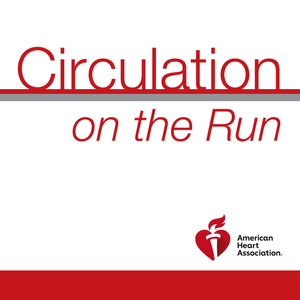
Circulation July 19, 2016 Issue
07/18/16 • 18 min
Speaker 1: Welcome to Circulation on the Run, your weekly podcast summary and backstage pass to the journal and its editors. I'm Dr. Carolyn Lam, Associate Editor from the National Heart Center and Duke National University of Singapore. Joining me in just a moment are Dr. James Gammie and Dr. Timothy Gardner to discuss our feature paper this week describing the first-in-human clinical experience with a novel transapical beating heart mitral valve repair.
First, here are the highlights of this week's journal. The first paper is from co-primary authors doctors Yoon, [Tsue 00:00:49], and [Cha 00:00:50] as well as corresponding authors Dr. [Che 00:00:55] and Dr. Kim from the Seoul National University College of Medicine. These authors examine mechanisms underlying diabetes-induced microvasculopathy, testing the hypothesis that Notch signaling in endothelial cells may play an important role in this condition.
The authors tested this hypothesis by inducing diabetes in eight-week-old adult mice using intravenous streptozotocin. They then modulated endothelial Notch signaling using chemical inhibitors in both wild type and transgenic mice. Results showed that the Notch ligand called Jagged-1 was markedly increased in endothelial cells of diabetic mice. Using endothelial specific Jagged-1 knocked down mice, they found that blocking Jagged-1 prevented diabetic microvaculopathy. Furthermore, using the induceable endothelium-specific Jagged-1 knocked down mice, blocking Jagged-1 even at four weeks after the establishment of diabetic microvaculopathy could reverse the condition.
In summary, these findings show that diabetes induces Jagged-1 over expression and suppresses Notch signalling in endothelial cells leading to diabetic microvaculopathy in adult mice. The clinical implications are that dysregulated intercellular Notch signalling may therefore represent a novel molecular target in the treatment of diabetic retinopathy.
The next study by Dr. Smith and colleagues at the Leiden University Medical Center in the Netherlands evaluated the association between LDL cholesterol variability and four cognitive domains at 30 months in the 4428 participants of the prosper study.
Results showed that a higher LDL cholesterol variability was associated with lower cognitive test performance for intermediate and delayed memory-related tasks, selective attention, and processing speed. Higher LDL cholesterol variability was also associated with lower cerebral blood flow and greater white matter hyperintensity load in an MRI substudy of 535 patients.
In addition to being independent of the mean LDL cholesterol levels and of clinically overt cardiovascular diseases, these associations were present both in the placebo and pravastatin treatment [inaudible 00:03:43] of the prosper trial suggesting that the findings did not mearly reflect pleiotropic effects of statins or of nonadherence.
The study importantly provides the first observational evidence that lipid variability, not just absolute or mean values, but the variability, maybe of importance to neurocognitive function and thus contributes while understanding potential pathways of neurocogniticve decline.
The next study is by first author, Dr. [Huh 00:04:19], and corresponding author, Dr. Ralph, from the Menzies School of Health Research Charles Darwin University in Australia. These authors aimed to investigate the long term outcomes from acute rheumatic fever and rheumatic heart disease.
They achieved this aim by using linked data between the rheumatic heart disease register, hospital data, and death register for residents of the northern territory of Australia, and examined 1248 patients with rheumatic heart disease as well as 572 patients with acute rheumatic fever in the period 1997 to 2013.
The main findings were that in the first year after an acute rheumatic fever episode, the incidents of progression to rheumatic heart disease was 10 times higher than acute rheumatic fever recurrence; 10% of rheumatic heart disease patients had severe disease at diagnosis. The presence of comorbidities was associated with higher incidence of rheumatic heart disease complications and mortality. In particular, comorbid renal failure and hazardous alcohol use accounted for 28% of the access indigenous mortality.
These findings have global relevance for settings with high acute rheumatic fever, rheumatic heart disease rates and really emphasized the need for integrated chronic disease management strategies for these patients.
The final paper is by first author Dr Bettencourt, corresponding author Dr. Blankstein, and colleagues from Brigman and Women's Hospital in Boston, Massachusetts. These authors sought to answer the question what is the most appropriate score for evaluating the pretest probability of obstructive coronary artery disease?
To answer the question, the authors compared t...
Speaker 1: Welcome to Circulation on the Run, your weekly podcast summary and backstage pass to the journal and its editors. I'm Dr. Carolyn Lam, Associate Editor from the National Heart Center and Duke National University of Singapore. Joining me in just a moment are Dr. James Gammie and Dr. Timothy Gardner to discuss our feature paper this week describing the first-in-human clinical experience with a novel transapical beating heart mitral valve repair.
First, here are the highlights of this week's journal. The first paper is from co-primary authors doctors Yoon, [Tsue 00:00:49], and [Cha 00:00:50] as well as corresponding authors Dr. [Che 00:00:55] and Dr. Kim from the Seoul National University College of Medicine. These authors examine mechanisms underlying diabetes-induced microvasculopathy, testing the hypothesis that Notch signaling in endothelial cells may play an important role in this condition.
The authors tested this hypothesis by inducing diabetes in eight-week-old adult mice using intravenous streptozotocin. They then modulated endothelial Notch signaling using chemical inhibitors in both wild type and transgenic mice. Results showed that the Notch ligand called Jagged-1 was markedly increased in endothelial cells of diabetic mice. Using endothelial specific Jagged-1 knocked down mice, they found that blocking Jagged-1 prevented diabetic microvaculopathy. Furthermore, using the induceable endothelium-specific Jagged-1 knocked down mice, blocking Jagged-1 even at four weeks after the establishment of diabetic microvaculopathy could reverse the condition.
In summary, these findings show that diabetes induces Jagged-1 over expression and suppresses Notch signalling in endothelial cells leading to diabetic microvaculopathy in adult mice. The clinical implications are that dysregulated intercellular Notch signalling may therefore represent a novel molecular target in the treatment of diabetic retinopathy.
The next study by Dr. Smith and colleagues at the Leiden University Medical Center in the Netherlands evaluated the association between LDL cholesterol variability and four cognitive domains at 30 months in the 4428 participants of the prosper study.
Results showed that a higher LDL cholesterol variability was associated with lower cognitive test performance for intermediate and delayed memory-related tasks, selective attention, and processing speed. Higher LDL cholesterol variability was also associated with lower cerebral blood flow and greater white matter hyperintensity load in an MRI substudy of 535 patients.
In addition to being independent of the mean LDL cholesterol levels and of clinically overt cardiovascular diseases, these associations were present both in the placebo and pravastatin treatment [inaudible 00:03:43] of the prosper trial suggesting that the findings did not mearly reflect pleiotropic effects of statins or of nonadherence.
The study importantly provides the first observational evidence that lipid variability, not just absolute or mean values, but the variability, maybe of importance to neurocognitive function and thus contributes while understanding potential pathways of neurocogniticve decline.
The next study is by first author, Dr. [Huh 00:04:19], and corresponding author, Dr. Ralph, from the Menzies School of Health Research Charles Darwin University in Australia. These authors aimed to investigate the long term outcomes from acute rheumatic fever and rheumatic heart disease.
They achieved this aim by using linked data between the rheumatic heart disease register, hospital data, and death register for residents of the northern territory of Australia, and examined 1248 patients with rheumatic heart disease as well as 572 patients with acute rheumatic fever in the period 1997 to 2013.
The main findings were that in the first year after an acute rheumatic fever episode, the incidents of progression to rheumatic heart disease was 10 times higher than acute rheumatic fever recurrence; 10% of rheumatic heart disease patients had severe disease at diagnosis. The presence of comorbidities was associated with higher incidence of rheumatic heart disease complications and mortality. In particular, comorbid renal failure and hazardous alcohol use accounted for 28% of the access indigenous mortality.
These findings have global relevance for settings with high acute rheumatic fever, rheumatic heart disease rates and really emphasized the need for integrated chronic disease management strategies for these patients.
The final paper is by first author Dr Bettencourt, corresponding author Dr. Blankstein, and colleagues from Brigman and Women's Hospital in Boston, Massachusetts. These authors sought to answer the question what is the most appropriate score for evaluating the pretest probability of obstructive coronary artery disease?
To answer the question, the authors compared t...
Previous Episode

Circulation July 12, 2016 Issue
Dr. Lam: Welcome to Circulation on the Run. Your weekly podcast summary and backstage pass to the Journal and it's editors. I'm Dr. Carolyn Lam, Associate Editor from the National Heart Center, and Duke National University of Singapore. Dr. Sanjay Kaul and Darren McGuire will be joining me in just a moment to share their perspectives on the EMPA-REG OUTCOME trials. Are the results with empagliflozin in diabetic patients at high risk, are they too good to be true. First, here are the highlights from five original papers in this week's issue.
The first paper is from Dr. Gilboa, from the National Center on Birth Defects and Developmental Disabilities, Centers for Disease Control and Prevention in Atlanta, Georgia, and Dr. Marelli from the McGill Adult Unit for congenital heart diseases in Montreal, Quebec, and colleagues. These authors recognize that because of advancements in care there has been a decline in mortality from congenital heart defects over the last several decades. However, there are still no current empirical data documenting the number of people living with congenital heart defects in the United States.
These authors address this gap in knowledge by using prevalence data from Quebec, Canada, in the year 2010, as a foundation for a mathematical model, and estimated that in the United States in the year 2010, approximately 2.4 million people, including 1.4 million adults, and 1 million children were living with congenital heart defects. This estimate is significant, because it corresponds to a 63% increase in the estimated size of the adult population with congenital heart defects in the United States since the year 2000. This has significant implications for resource allocation for health services delivery that will need to account for this growing population of adults with congenital heart defects.
The second paper is from first author Dr. Tabot, and corresponding author Dr. Liao, from the University of Chicago, and colleagues who aim to understand better the common complication of angiodysplasia leading to nonsurgical bleeding in patients with left ventricular assist devices. The authors studied 101 patients with heart failure, left ventricular assist devices, or orthotopic heart transplants. They found that compared to patients with heart failure, or transplant patients, patients with left ventricular assist devices had elevated serum levels, and endothelial expression of angiopoietin-2, which is a potent angiogenic mediator.
Elevated levels of angiopoietin-2 in these patients increase angiogenesis in vitro, and were associated with bleeding events. Furthermore, they found that increased thrombin levels in left ventricular assist device patients were associated with elevated angiopoietin-2 levels. In aggregate, therefore, the results indicate that high levels of thrombin induced endothelial angiopoietin-2 expression, which may then contribute to angiodysplasia and non-surgical bleeding in patients with left ventricular assist devices. The clinical implications are that clinical studies angiopoietin-2, and factor 12 inhibitors may therefore be indicated to prevent nonsurgical bleeding in patients with left ventricular assist devices.
The third paper is Dr. Gordon from Hasbro Children's Hospital in Rhode Island, and Dr. Kieran from the Dana Farber Cancer Institute in Boston, Massachusetts, and colleagues who addressed the Hutchinson Gilford Progeria Syndrome. An extremely rare, fatal segmental premature aging syndrome, where without specific treatment, death usually occurs at an average age of 14 1/2 years from an accelerated atherosclerosis.
A PRIA single arm clinical trial has demonstrated that the protein farnesyltransferase inhibitor, Lonafarnib, ameliorates some aspects of cardiovascular and bone disease in this syndrome. The current trial sought to further disease outcomes by additionally inhibiting progerin prenylation using pravastatin and zoledronic acid on top of Lonafarnib in 37 participants with the Progeria syndrome. Results showed that the composite primary study outcome of increased rate weight gain and decreased carotid artery echodensity was achieved. Overall, participants experienced increased bone density, size, and structural properties. However, unlike the PRIA single arm Lonafarnib monotherapy trial, mean carotid-femoral pulse wave velocity and mean carotid artery adventitial echodensity were not improved. In addition, rates of carotid and femoral artery plaques and extraskeletal calcifications all increased.
In summary, compared PRIA Lonafarnib monotherapy treatment, additional bone mineral density benefit, but likely no additional additional cardiovascular benefit was obtained with the addition of pravastatin and zoledronic acid. The authors concluded that since increased bone fracture is not a disease feature, the addition of a combination of statin and biphosphonate to Lonafarnib therapy is not recommended...
Next Episode

Circulation July 26, 2016, Issue
Carolyn: Welcome to Circulation on the Run, your weekly podcast summary and backstage pass to the journal and its editors. I'm Dr. Carolyn Lam, Associate Editor from the National Heart Centre and Duke National University of Singapore. I am so excited to be joined in just a moment by Dr. Andrea [inaudible 00:00:21] and Dr. Wendy Post to discuss the feature paper this week about leisure-time physical activity and the risk of coronary heart disease in young women. First, here's the summary of this week's issue.
The first paper, by Dr. Bohula and colleagues at the TIMI Study Group at Brigham and Women's Hospital in Boston, Massachusetts, aim to test the hypothesis that an atherothrombotic risk stratification tool may be useful to identify high-risk patients who have the greatest potential for benefit from more intensive secondary preventive therapy such as treatment with Vorapaxar following a myocardial infarction. As a reminder, Vorapaxar is a first-in-class anti-platelet agent that inhibits thrombin-mediated activation of platelets via the protease activator receptor 1. The authors studied almost 8,600 stable patients with a prior myocardial infarction followed for a median of two and a half years.
In the thrombin receptor antagonist and secondary prevention of athrothrombotic ischemic events, TIMI 50 trial. They identified nine independent risk predictors which were age, diabetes, hypertension, smoking, peripheral artery disease, prior stroke, prior coronary bypass grafting, heart failure and renal dysfunction. A simple integer-based scheme using these predictors showed a strong graded relationship with the rates of cardiovascular death, myocardial infarction or ischemic stroke. Moreover, the net clinical outcome was increasingly favorable with Vorapaxar across the risk groups.
In summary, this paper provides a practical strategy that could be used by clinicians to assist with risk stratification and therapeutic decision-making regarding Veropaxar use for secondary prevention after myocardial infarction.
The next paper is by first author Dr. [inaudible 00:02:40] and corresponding authors, Dr. [Gerstein 00:02:43] from the Beth Israel Deaconess Medical Center and Dr. [Carr 00:02:47] from the Broad Institute of Harvard and MIT, who look at aptamer-based proteomic profiling. Now DNA aptamers are [alu 00:02:57] nucleotides of approximately 50 base pairs in length selected for their ability to bind proteins with high specificity and affinity. They therefore holds considerable promise for biomarker and pathway discovery in cardiovascular diseases.
These authors applied a novel technology that uses single-stranded DNA aptamers to measure over 1,100 proteins in a single blood sample. They applied this to a model of planned myocardial injury and that is patients undergoing septal ablation for hypertrophic cardiomyopathy, and they found that 217 proteins were significantly changed in the peripheral vein blood after planned myocardial injury in this derivation cohort. They validated 79 of these proteins in an independent cohort. Furthermore, among 40 validated proteins that increase within one hour after myocardial injury, 23 were also elevated in patients with spontaneous myocardial infarction.
Finally, the authors applied this to archive samples from the Framingham heart study and showed 156 significant protein associations with the Framingham risk score. This study is so exciting because it highlights any merging proteomics tool that captures a large number of low abundance analytes with high sensitivity and precision, thus providing important proof of principle for future clinical applications and this is discussed in an excellent editorial that accompanies this paper by doctors Graham [Malini 00:04:37], [Lau Enleui 00:04:39] from the University of Ottawa Heart Institute.
The next paper is by Dr. [Anter 00:04:51] and colleagues from the Beth Israel Deaconess Medical Center in Boston, Massachusetts, who looked at post infarction, reentrant ventricular tachycardia and addressed the problem that in vivo descriptions of ventricular tachycardia circuits are currently limited by insufficient spatiotemporal resolution. The authors therefore utilize a novel, high resolution mapping technology to characterize the electrophysiological properties of these reentrant circuits in 15 swine.
The main finding was that the zones of slow conduction within the reentrant circuits with the inward and outward curvatures while conduction velocity in the comment channel isthmus itself was nearly normal. The authors further demonstrated that entrainment mapping over estimated the true size of the isthmus. Thus, the conclusion was that high resolution activation mapping of ventricular tachycardia may better guide ablation therapy and ablation at zones of high curvature may be an attractive target for ablation.
The final papers from first author, Dr. [Tang 00:06:08...
If you like this episode you’ll love
Episode Comments
Generate a badge
Get a badge for your website that links back to this episode
<a href="https://goodpods.com/podcasts/circulation-on-the-run-255644/circulation-july-19-2016-issue-29730704"> <img src="https://storage.googleapis.com/goodpods-images-bucket/badges/generic-badge-1.svg" alt="listen to circulation july 19, 2016 issue on goodpods" style="width: 225px" /> </a>
Copy




